UPDATE (March, 2017): This article was published on 2014 and since that time quite some things has changed. Especially because the 3×8 speed components are no longer available in needed quality and it is very difficult or even impossible to find good front forks for V-brakes. So our current recommendation is Shimano Deore 3×9, with MEKS fork (no longer available with V-brakes) and mechanical disc brakes Avid BB7. The rest remains the same.
In last couple of years we have been building lot of bikes for long distance touring or even for expeditions. Our experience in building such bikes and trikes comes not only from all those bikes traveling in different parts of the world or around it, but also from personal experience as our sales and marketing manager Honza Galla is used to travel quite a lot. He cycled in Indian Himalayas, crossed Negev desert in Israel riding on mostly gravel roads and single trails or traveled in Kosovo and Albania. His last adventure was a race of solar bikes from France to Kazakhstan called The Sun Trip where he and his team mate used two AZUB TRIcon trikes. See more here: www.czech-solar-team.com.
When talking about all the other journeys, you can find some stories here on our blog. There are tons of pictures and many videos. Among the most remarkable are journey of Marija Kozin from Beijing to Skofja Loka in Slovenia or the AZUB TWIN WORLD TOUR. But there are also many others which we do not know about, or we did not have a time to publish any article about them.
Thanks to all comments, feedbacks, experiences and suggestions from different riders, we think now, we know how the best touring recumbent should look like, what components to use and why. There might be some better components on the market, but we cannot offer them because of different reasons. They are usualy far more expensive and we are not sure whether they are worth spending such money. Here is a description of all different details, our thoughts and suggestions and maybe some recommendations for some even better components as well.

We think that this is the best model for touring – the AZUB SIX with ASS (above seat steering), front suspension, full set of carriers, simple 3×8 Alivio components, V-brakes etc. And why AZUB SIX? It doesn`t really matter whether you are small or tall, this bike will fit you and you will feel comfortable on it. Not only on flat asphalt roads when you are fresh, but also on gravel roads climbing somehwhere into heaven (or hell at that time) when you are tired and maybe also frozen, with all the heavy luggages around you on the bike. Than stoping and getting off the bike with 26″ front wheel would be very difficult or at least problematic as well as taking pictures or resting. And this is truth for all of you up to 190 cm or even more. You might read also Honza`s explanation here. So we really recommend 20/26″ concept against dual 26″ bikes.
Another question might be if the cheaper AZUB Apus would be a good option as well. Yes, it is still very durable AZUB recumbent, but we prefer the AZUB SIX. It is simply the best recumbent we can produce for reasonable money. It has very stiff rear fork as well as cartridge bearings in the rear fork axle set and also pulley which makes the efficent of pedaling as good as possible.

Above seat steering is pretty important. At the beginning we thought the best would be USS (under seat steering) as it is very comfortable and we like it a lot. Also we think we have one of the best USS on the market. But later somebody asked which steering is really bomb-proof in terms it cannot be demaged or if something ahppen, it can be easy to repair somehow. And the answer is ASS. With USS, if you fall, a system which we call AZUB Safety System can protect your handlebars by rotating of them a bit, but sooner or later your bars will be bent. We have improved them in 2013 and they are from Cro-Mo now, but ASS are better for expeditiuons from this point of view. They are not so exposed when you have little or big accident. They are very comfortable. They are narrow so it is easier to manipulate with them when you need to get the bike into your hotel room or into a bus or even an airplane etc. By the way, here is an article describing traveling with recumbent by public transport. So…ASS…This is the choice.
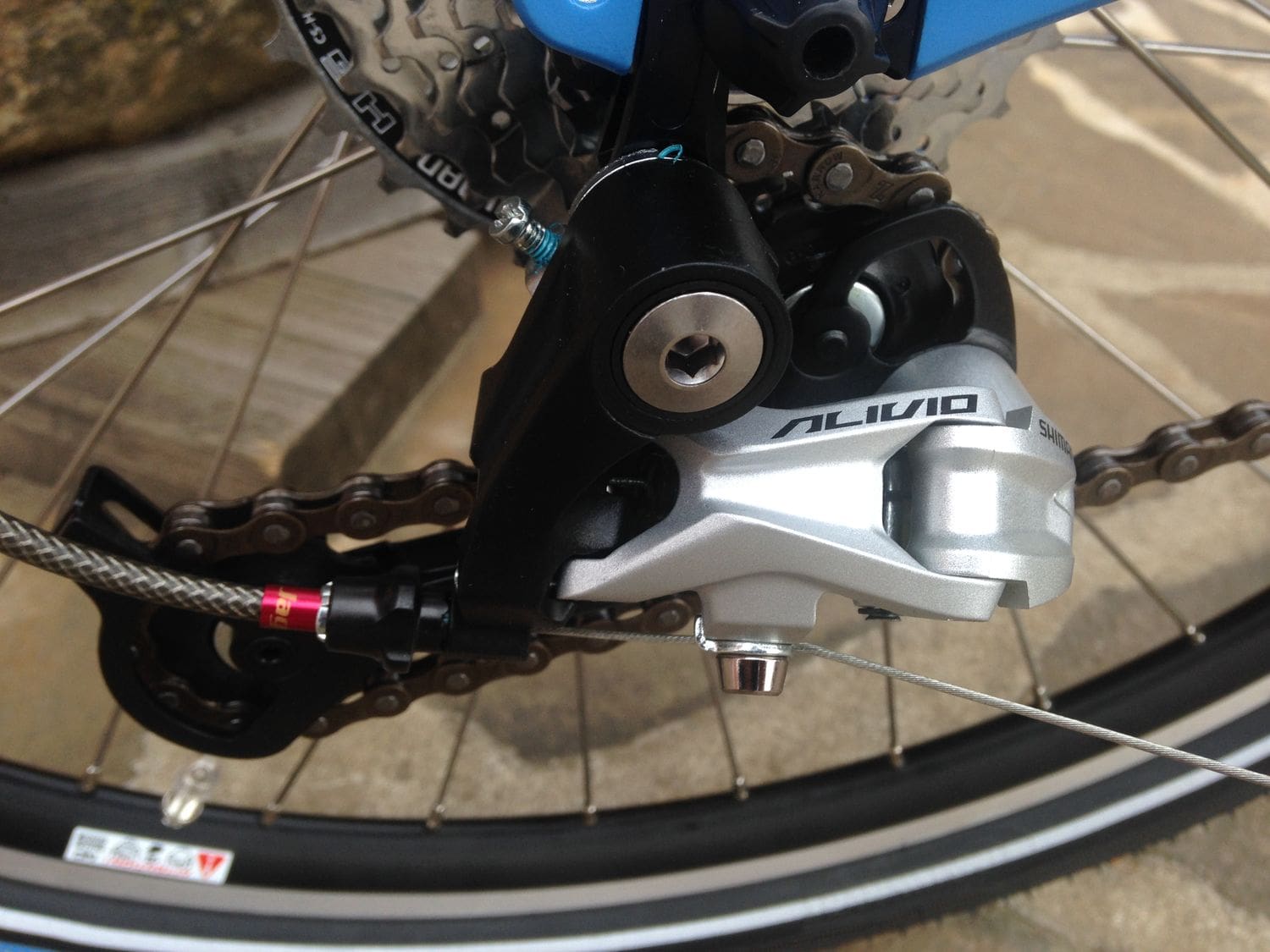
Shimano Alivio might look pretty old school especialy with only 3×8 gears, BUT this is the best component level using 8 speed chain which is wide and so lasts far longer than 9 or even 10 speed chains. And it is also widely available in all different countries around the world. It is a bit sad that Shimano or SRAM or of smaller producers do not offer some real touring component level which would be durable enough for serious traveling. It seems that “durability” is not a fashion now. This is the reason why we offer Alivio as the best touring component level. For some it doesn`t shift as good as XT or XTR, for some it is too heavy, but for us it is good enough. Marija Kozin did over 17.000 km with just one chain, one cassette and one crankset.
We have also tried to combine Alivio shifters with Deore or Deore XT derailleurs which was working fine like 5 years ago, but in last years shifting was hard and cooperating of such components did not work well.
Another option might be 14 speed geard hub Rohloff. A great piece of engineering from Germany which has superb quality and there are some untis which provide excelent service to their owners for more than 200.000 kilometers. But it is also very expensive and time to time some travelers spend lot of money on Rohloff hub and save them on brakes, shocks or accessories which we think doesn`t make sense. The bike should be equiped in balance. And you also have to consider that oil should be changed every 5000 km and if anything fail it will be veeery hard to get a spare part of a service.

Crankset. Probably the only one component where we are not sure what to recommend. Either some for square type of bottom bracket or the one with integrated axle. We have never experienced fatal crankset failure and all we have ever assembled survived pretty well. Yes, they had to be changed after 12 or 15.000 kilometers, but never let any rider somewhere next to the road because of some failure. From service point of view square type bottom bracket is better, but integrated axle is usualy of higher quality, the axle is more solid and bearings are of larger diamter so they should survive longer. We would not go for Octalink or ISIS bottom bracket as they are not available at all in countries like Kyrgyzstan or so.
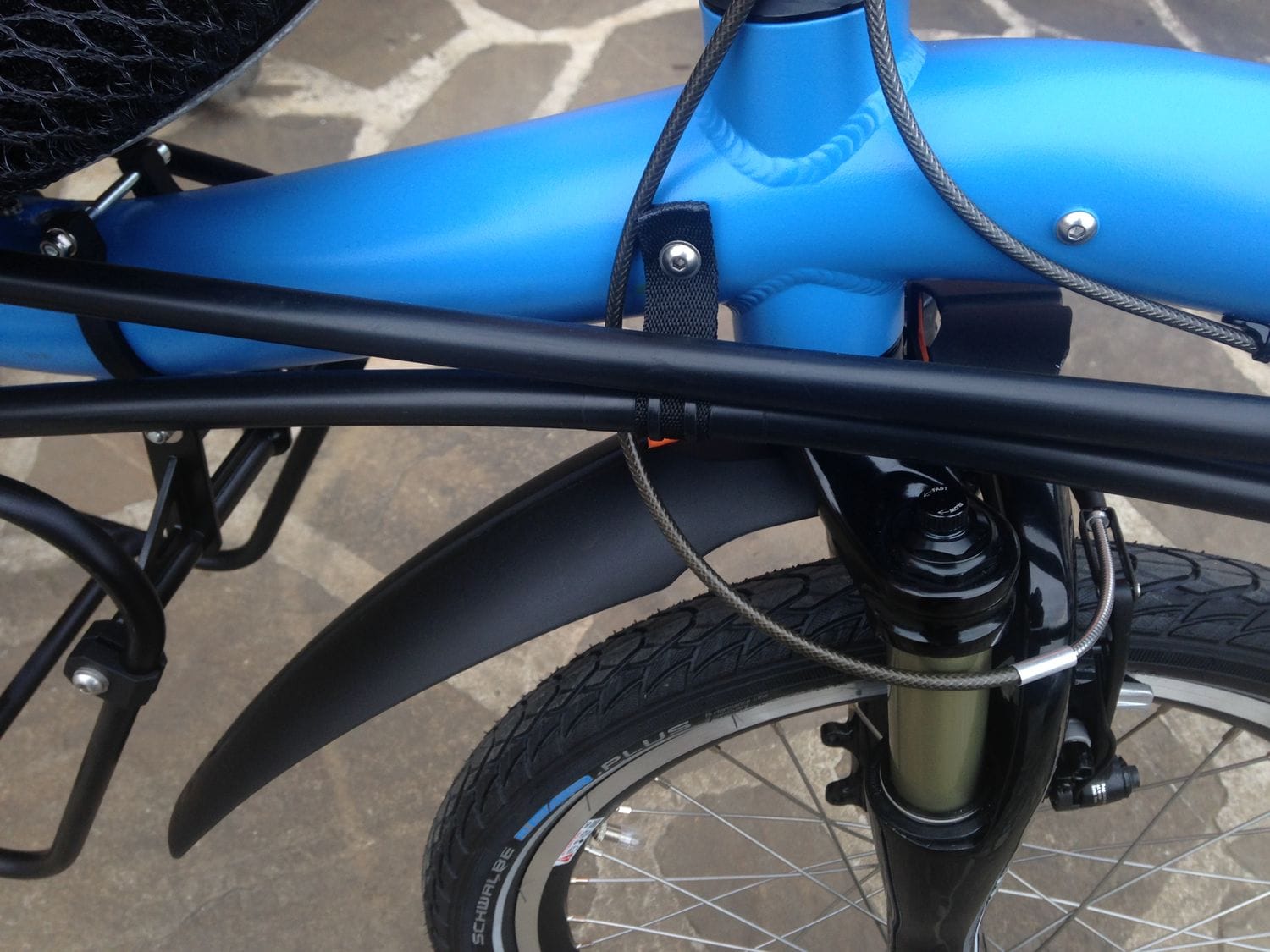
We have just one choice of chain tubes. Our experience is that they last something like 10.000 kilometers normaly, but if you are on long journey, 15.000 or maybe even 20.000 kilometers and they will provide their function. On this picture you can also see routing of brake cable housings to front brake which we like and use and also front MTB-style mudguard which is supposed to be used with 26″ wheels but works fine with 20″ as well. It is cut in front a bit so there is enough room for above mentioned chain tubes and cable housings as well as for your heel when you turn.

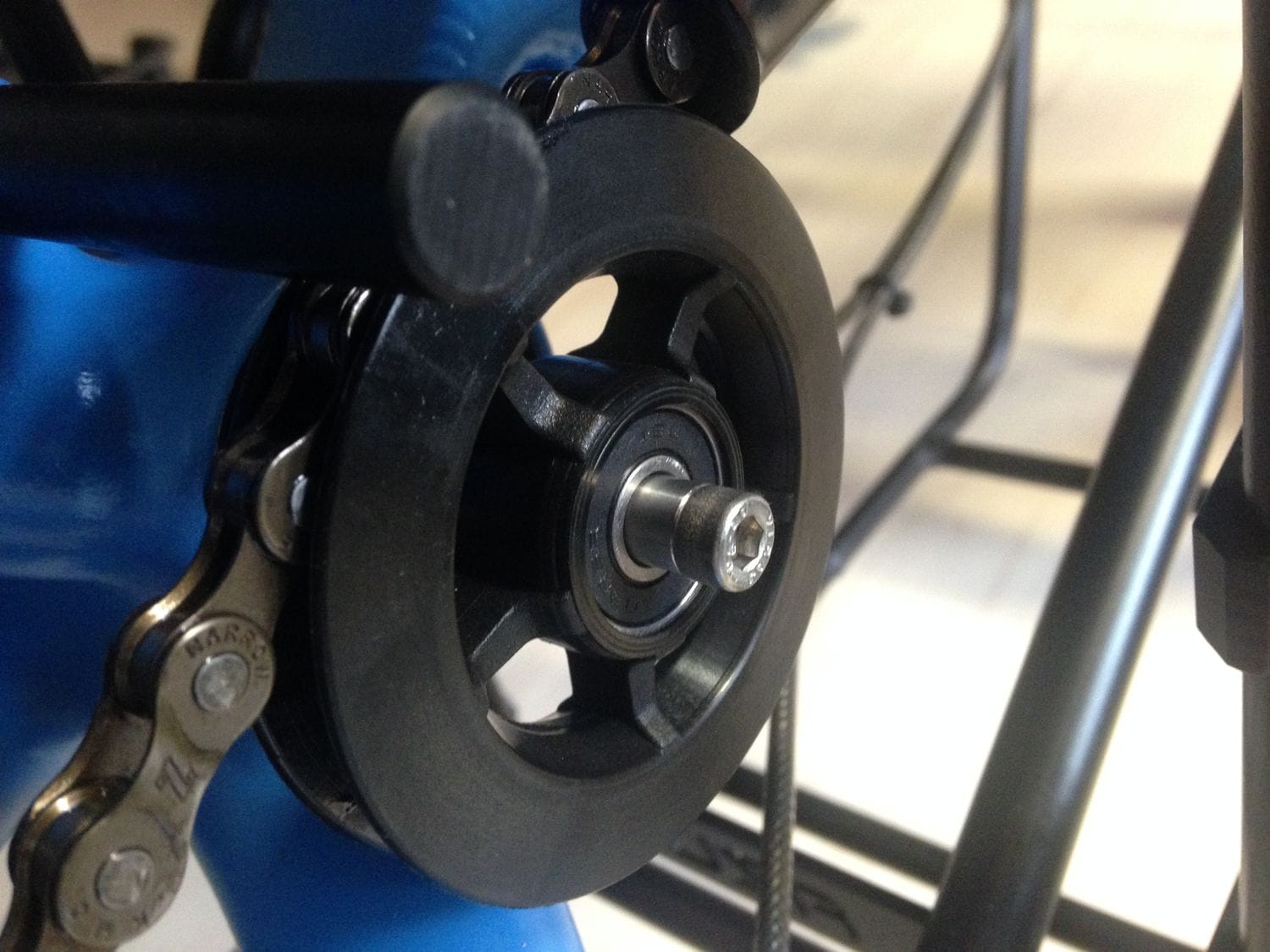
Staying with chain topic, here is our movable chain pulley (idler) which increase the efficency of pedaling compare to bikes without any pulley and eliminates the po-go effect. The fact that it moves decrease the need of the chain to bend and cross based on which combination of sprockets and chain wheels you have chosen. It is alsoi quieter and the chain lasts longer. We have improved the system a bit for 2014 season and we use the same pulley for trikes and bikes now.
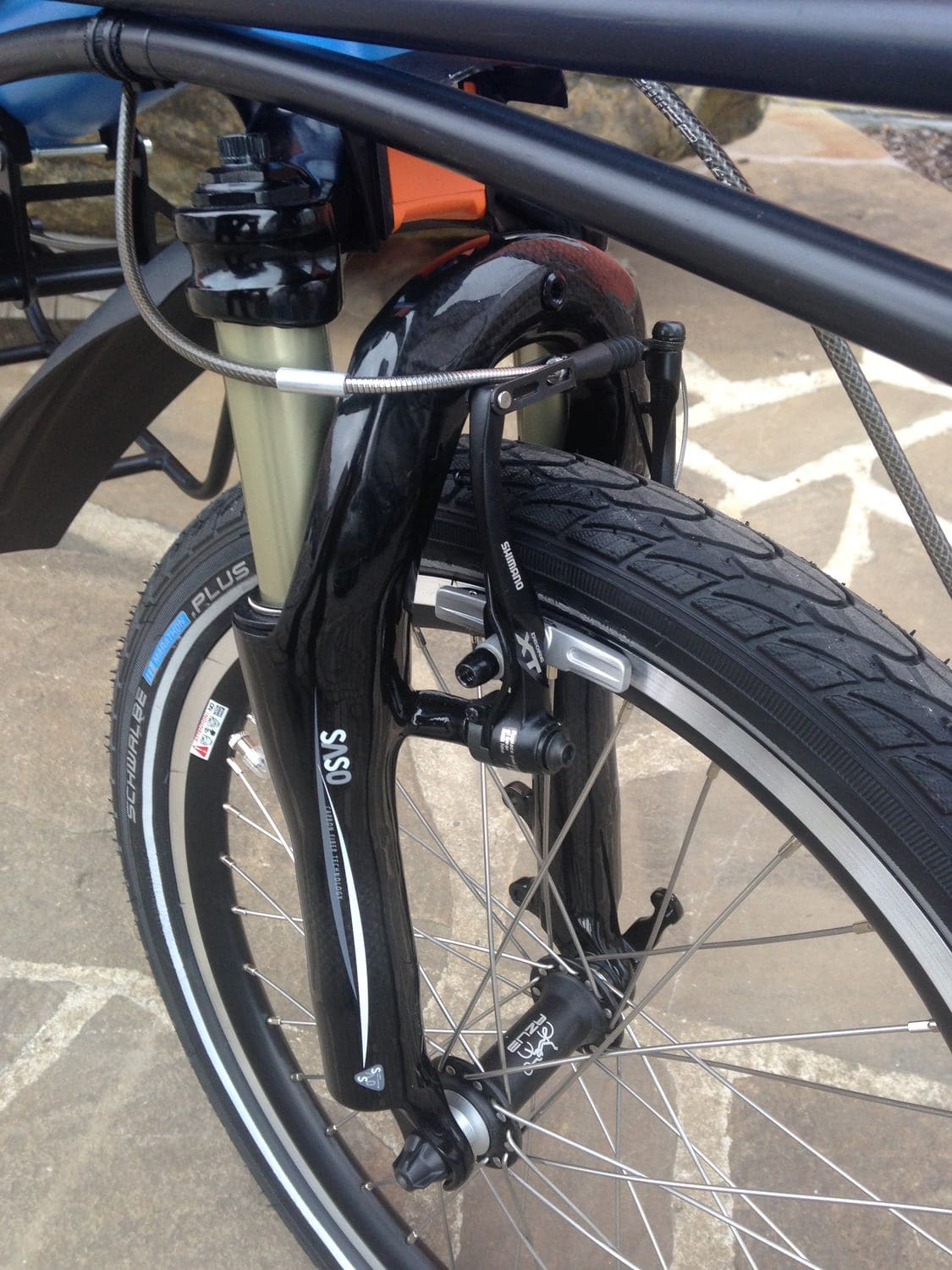
Recumbent with 20″ front fork going to countries where there are parts with bad asphalt roads or no asphalt roads should have front suspension. Dual 26″ wheel bikes like the AZUB MAX can have only rigid front fork (we recommend our Cro-Mo option), but the AZUB SIX should have front suspension. The bike will suffer lot less and you will have an absolute comfort riding the bike. The MEKS is probably the best compromise between price and function/quality and we have very good experience with it. Compare to basic Spinner Grind suspension fork, MEKS is much lighter and has lock out, although Spinner has a very good lifetime as well.
You can see also front hub we use on the picture. This is Novatec hub with our own logo on it and it has cartridge bearings inside. We use the same hub in the rear. Or better to say one from the same level. Some of you would go for SON hub dynamo. Those are of even higher quality and will do the same perfect job during your long ride. Not talking about Rohloff in the rear.

Rear suspension is absolute must on short wheel base recumbents build for touring. There is no chance to stand into pedals as on upright (or upwrong? 🙂 bikes and your body and back would suffer a lot on any bad roads. We think an air shock is very good choice as weight of the bike can change significantly during long journeys and between different trips. Once you need lot of water and food, once clothes for cold wether, once just almost nothing for touring in sunny France. Also for those of you who use one recumbent for holidays and one for commuting an air shock is the best choice. By changing the preasure you can harden it or soften it so its properties will adjust to amount and weight of luggages you have on the bike. Yes, you need high preasure pump, but this can be an emergency tyre pump in case you loose or demage your main one (we know, we know it would take years to pump a tyre, but we said “emergency”). Until now, we have very good experience with Suntour Epicon shock which provides also lock out and rebound adjustment, but if you have enough big budget, go for the FOX which is of better quality, offers not only lock out but also pro pedal (decreasing the po-go effect) and seems to be the best choice.
The neoprene cover is a very good protection againts spray water, dust and mud and if you use it you do not need a mudguard because your body and all the equipment is protected by the super-oversized main frame tube and rear carrier. And we have to say it is somewhat complicated to attach good rear MTB-style mudguard on our bikes and standard SKS mudguards we deliver with other bikes would not be good because when you will appear in muddy conditions you will be stucked with all the mud in between wheel and mudguard which cannot be easily dismounted.

V-brakes or disc brakes. Or even hydraulic rim brakes? You can discuss about that for hours and we sometimes do with our customers, but our opinion is simple. V-brakes. They need less manitenance, do not need special brake pads, can work even when they are not adjusted perfectly and are chaper. Badly adjusted disc brakes are worse than average V-brakes not talking about the risk of bending the disc during transport or an accident. For toruing bikes we usualy recommend Shimano XT V-brakes which have very good power and you can change just the rubber part of the barke pads so you do not need to carry couple of heavy brake pads but just the thin brake shoes. And as mentioned before you can buy any brake pads anywhere on the way and do not need to look for special brake pads just for your model of disc brakes. Another huge advantage is that V-brakes stress spokes, rim, front fork and frame of the bike far less than disc brakes.
Yes, yes, we know there are many disadvantages of V-brakes like lower braking power, noise when the rim is dirty, no function when the rim is demaged and not centred well, but in our eyes their advantages are more valuable for long distance cyclists.
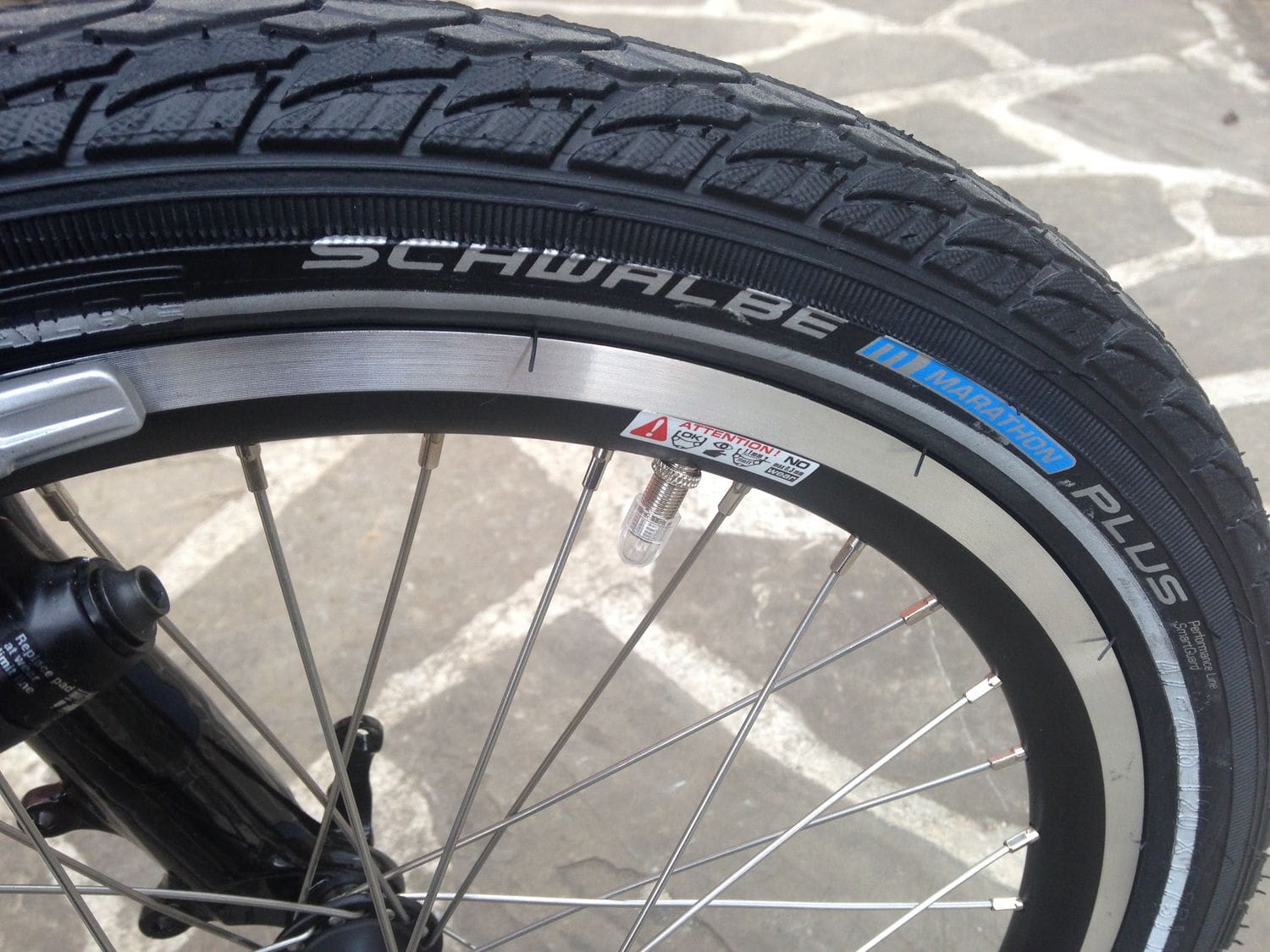
There is no doubt that Schwalbe Marathon XR were the best tyres for bicycle expeditions. They survived over 60.000 kilometers and could do it without any puncture. But they are no longer in production and the Marathon Extreme and Mondial nowadays are not that good anymore (does it remind you something about the durability and feshion?). But Schwalbe still is unbeatable and especialy the Marathon Plus tyre is great. And it is in both 20″ and 26″ wheel size. So either go for this set up or combine the Mondial in the rear with Marathon Plus in front in case you go for mostly gravel roads.

We offer two different types of seat pads. Either the standard seat pad which we recommend to use with seat pad cover or the Ventisit. This is made in Holland and will survive more than you and your bike together. Compare to standard set pad we offer is UV resistant, holds its shape and thickness all the time and the water goes through easily. Standard seat pad needs to be changed once a while (every two or three years normaly or maybe once a year on a continuous journey) and is prefered by some because of its greater comfort.
You can also have mesh seat we normaly use on our trikes also on our bikes, but we still kind of prefer hard shell seats with seat pads.


Adjustability is usualy important when you buy the bike and than you are looking for the best riding position, or when you want to borrow the bike to somebody, but it can be also good when you feel you need to change the postion a bit, or when there are very long uphills in front of you. Very long means like 30 or more kilometers. Than it make sense to make the seat position a bit steeper and move the seat a bit backward so you feel a bit better and you have more power in your legs. BTW: do you know that when you change the angle of the seat also the distance you need to sit comfortably between the seat and pedals change. That is why it is important to move the seat back or forth accordingly when you change the angle.
We are very proud of our system of sliding seat bracket and seat stays which allow very precise adjustment. The seat bracket is made our of plastic which is hardened by glass fibres and we do not have a single one broken inthe three years history of this piece. Very solid but light one.
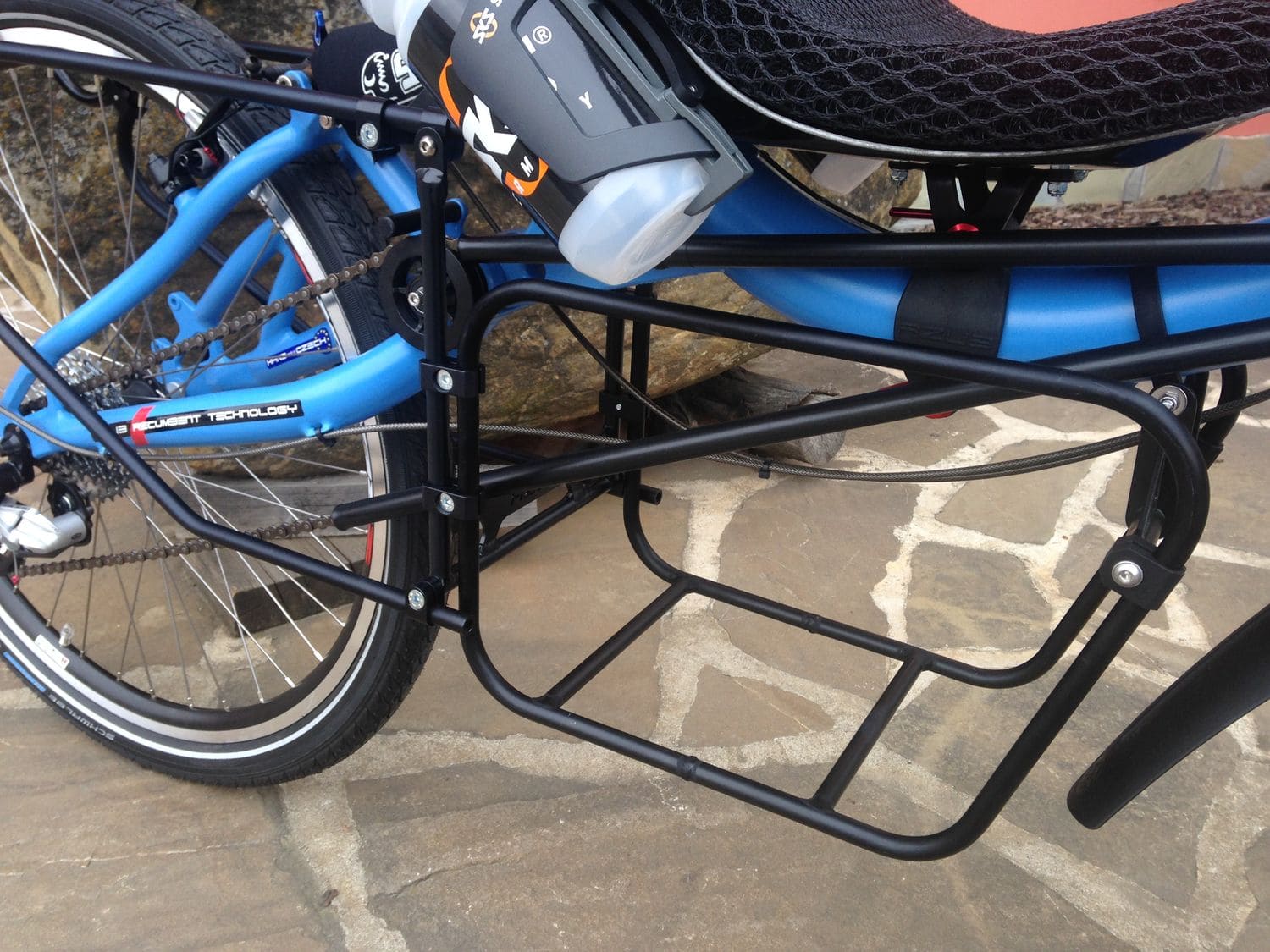
There are three different carriers for our recumbent bikes you can have. The Standard carrier. Its Expedition extension and the Super expedition carrier which could be called low rider. You can read more about each of them on their own pages, but the important thing is it really make sense tohave all of them on the bike. You would than have the back bags, for example Ortlieb Back-Rollers on the Expedition extension and Front-Rollers on Super expedition carrier which would move the centre of gravity very low and the bike would be veery stable than. Some lighter stuff can be carried on top of the Standard carrier. Or you can have up to three sets of panniers. To make things clear the Super expedition carrier can be assembled separetly, but Expedition extension require a Standard carrier tobe mounted as well.

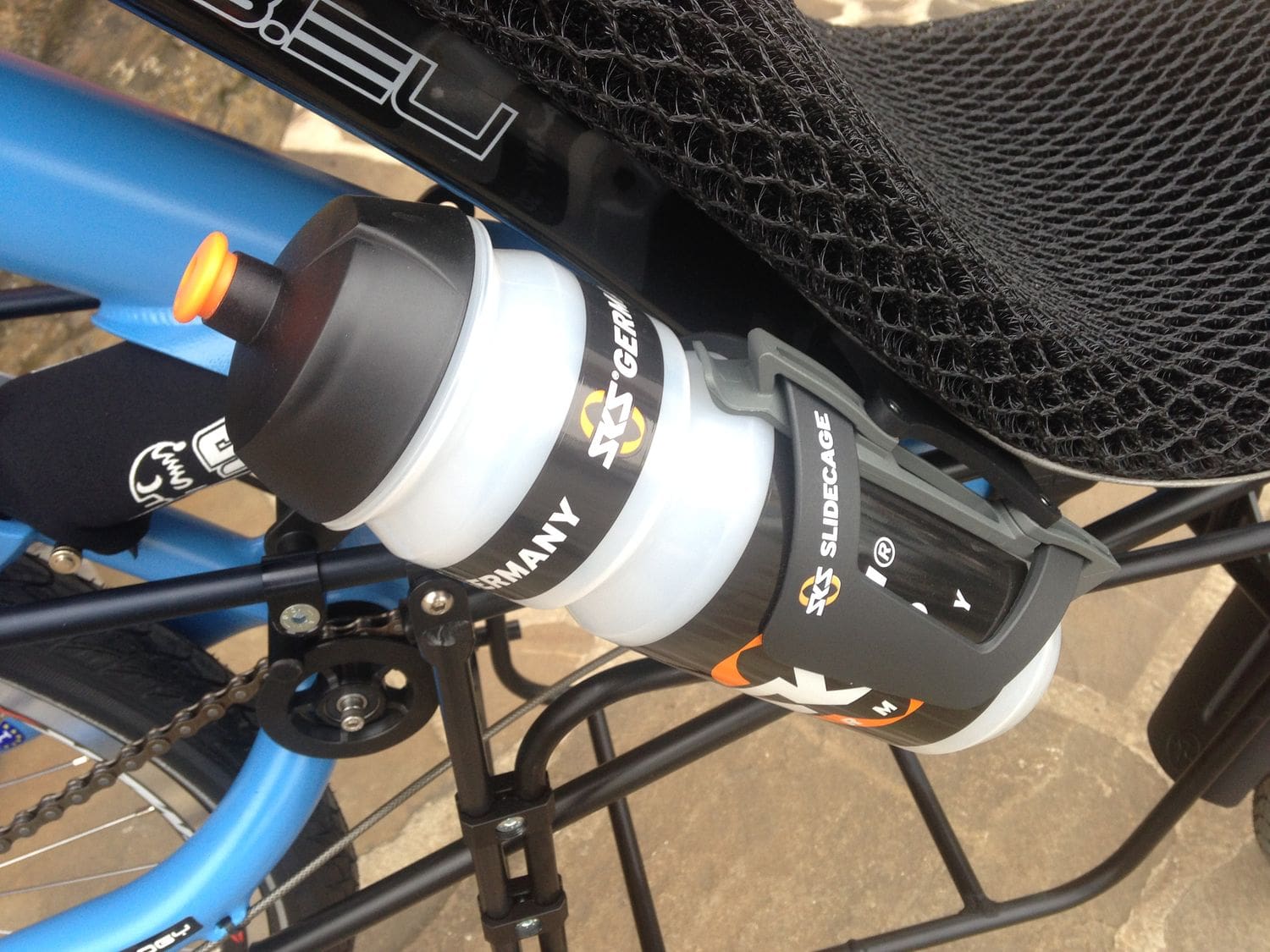
There are quite some other recumbent accessories you can order and which would make your journeys more comfortable, but all the above mentioned components and options are the most important.
If you are interested in different tools and spare parts we recommend forsuch journeys, you can read another blog entry here.
Also be aware that for recumbent tandems there are a bit different rules and we plan to write another article about this topic sooner or later too. Also about trikes. Or about bikes for commuting.
If you have any feed back, question, suggestion or so, feel free to post it as a comment or write us directly by e-mail. If you find this article useful we would also gladly hear about it among comments. Thanks!
F.A.Q.
Immediately after we published this article there have appeared some questions and comments and we realized we received some of them few more times before. So here are our answers and comments.
If you have 20″ and 26″ wheel on one bike, you need to have two different sizes of tyres and spokes.
On a standard bike with two same sizes of wheels you have two or event three different lengths of spokes as there are different hubs and in the rear you usualy have two sizes.
Of course, you have to have two sizes of tyres, but all the advantages 20/26″ set up gives you cannot be beaten by one more tyre and two tubes. Especialy when the bike is lighter thanks to smaller wheel.
At the end, nothing is black or white. There are always pros and cons and one have to decide. We just recommend what we think is the best option and what we would bring by ourselfs. (Honza uses AZUB Mini with two 20″ wheels because he likes the look of the bike as well as he uses a children trailer with 20″ wheel so he needs to have spares for the trailer as well. When they were in Himalayas with his wife, she used a trike with all three 20″ wheels so it was really convenient to have only 20″ wheels.)
There might be a problem to find spare parts for 20″ wheels when you are on the road.
You need to have spare parts with you. Mostly spokes. And what you might buy on the way are tyres or tubes. And 20″ is a standard size of children bikes so they are available all around the world. Yes, there might be a problem to get good quality rim or spokes if needed, but you can get those pretty quickly from Europe if really necessary. And remember, problems on the way are usualy bringing new relationships with local people and great experience. Avoiding problems means avoiding unforgetable moments, great memories and veeery good stories! 🙂





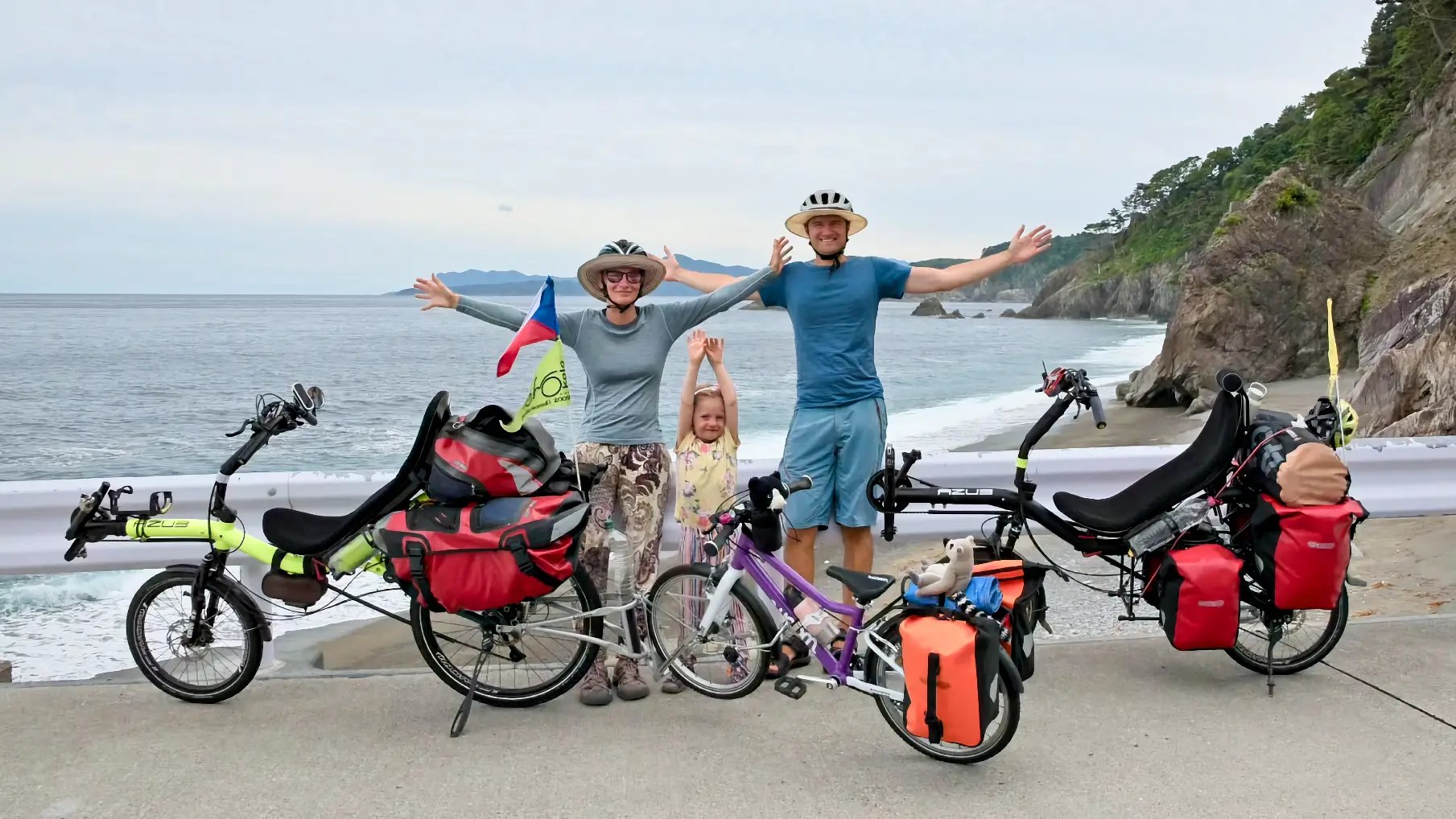
Join the worldwide group of AZUB fans
Get the latest stories, be inspired by our amazing builds and get some inside view.
You are close to join the fan group. Just see your inbox and confirm your e-mail address.